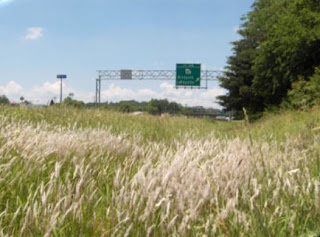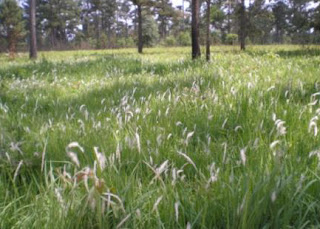Cogongrass in Georgia:
Spring 2013 Update from the Georgia Forestry Commission
Cogongrass flowering(seed production) becoming visible. Spring 2013 Update from the Georgia Forestry Commission
First cogongrass spot detected in Turner County.
Reports of Cogongrass as of 4-19-13
YEAR Detected spots Cum. # spots
Up to 2006 59 59
2007 37 96
2008 131 227
2009 110 337
2010 135 472
2011 130 602
2012 87 689
2013 34 723
How do you identify cogongrass flowers?
Cogongrass shoots in Georgia are beginning to emerge. Therefore, it is time to begin looking for cogongrass in its flowering stage. The flowers are 2-8 inches in length; light, fluffy dandelion-like seeds that are white in color and cylindrical in shape. Flowering time is dependent on the local climate, but is usually present from late March through early June. The cool spring weather in 2013 delayed the beginning of flowering until mid April in much of South Georgia. The photos below show cogongrass flowering at its peak, dispersal period.
 What are the top five cogongrass detecting counties in Georgia?
What are the top five cogongrass detecting counties in Georgia? Decatur 163 sites
Seminole 82 sites
Early 65 sites
Grady 55 sites
Thomas 51 sites
Currently in 2013, cogongrass has been detected in 14 counties across south Georgia including: Baker, Brooks, Calhoun, Camden, Charlton, Colquitt, Decatur, Early, Grady, Mitchell, Seminole, Terrell, Thomas and Turner counties. Landowners are encouraged to inspect their property for cogongrass and report any new potential detections to the local Georgia Forestry Commission county office.
Cogongrass identification brochure and pocket ID available from the GFC:
Landowners are encouraged to spend time on their property searching for this invasive grass. Normally, cogongrass grows in circular patches. Identification brochures are available at your local Georgia Forestry Commission (GFC) county office. Personnel from your local GFC office can make a positive identification on reported cogongrass finds. The "Cogongrass in Georgia" video showing the key identification features can be viewed at:
http://www.gatrees.org/ForestManagement/Cogongrass.cfm
Contact your local GFC County Office or Regional Forest Health Specialist to obtain copies of these two publications.

 |
| Dense mat, sharp pointed, covered in flaky scales, bright white under scales, strongly segmented. |
Leaves:
 |
2-5’ long blades, ½-1 inch wide, off-centered white mid-rib, margins finely serrated, green yellowish-green in color in summer with a tan color in winter. |
Circular growth pattern:
 |
| Grass patch will normally grow in a circular pattern. |
 |
| GaTrees.org - 1-800-GA-TREES |
Forest Health Specialists:
North Region: Lynne Womack
3086 Martha Berry Hwy,
Rome, GA 30165
(o) 706-295-6021
Cell 912-515-5180 lwomack@gfc.state.ga.us
Southwest Region: Mark McClure
NE 2910 Newton Rd.
Albany, GA 31701
(o) 229-430-5122
cell 229-869-8592
mmcclure@gfc.state.ga.us
Southeast Region: Chris Barnes
119 Hwy. 49
Milledgeville, GA 31061
(o) 478-445-5440
cell 912-601-7093
cbarnes@gfc.state.ga.us
Program Coordinator: Chip Bates
18899 US Hwy. 301 N.
Statesboro, GA 30461
(o)912-681-0490
cell 912-536-7544





